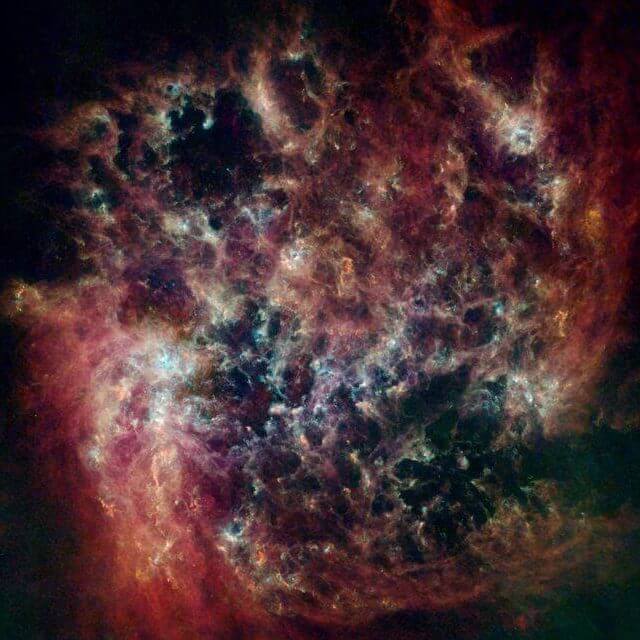To learn about the properties of the first stars to be born in the universe, it is currently believed that they were born from the remains of the first star.low metal starWe rely on indirect methods to find out “. Low-metallic stars are extremely rare, accounting for about 1 in 100,000 stars, and most of the stars whose properties have been investigated in detail so far belong to the Milky Way Galaxy.
A research team led by Anirudh Chiti of the University of Chicago has discovered the Milky Way’s satellite galaxy,large magellanic cloud” and selected 10 low-metallic stars from among them for analysis. the result,Low-metallic stars in the Large Magellanic Cloud have different element ratios than most low-metallic stars in the Milky Way.It turns out that. Differences in the ratio of elements are thought to reflect differences in the environments in which low-metallic stars were formed, and therefore provide important clues for exploring the state of the early Universe.
[▲ Figure 1: Composite image of the Large Magellanic Cloud taken by Herschel Space Observatory, Planck, IRAS, and COBE (Credit: ESA, NASA, JPL-Caltech, CSIRO & C. Clark (STScI))]
■“Low-metallic stars” are clues to the yet-to-be-seen first generation stars
What kind of properties did the first stars (population III) that were born in the universe have? It is thought that such stars do not exist anywhere near us, as they have an enormous mass of several hundred times that of the Sun and reach the end of their lifespans quickly (less than 1 million years). The James Webb Space Telescope, which recently began operation, is expected to be able to observe the history of early galaxies in the extremely distant universe and learn about the properties of the first stars, but it is unclear whether this will be a success. I don’t know yet.
Therefore, for now, we are looking at the second-generation star, which was formed from the remains of the first-generation star, as a clue to the properties of the first-generation star.low metal star” (race II) is attracting attention. Unlike the first stars, low-metallic stars have a mass as small as the Sun, so they still exist in the Milky Way even now, more than 10 billion years after their birth.
A low-metallic star is a term that literally means a star with a lower metal content than new stars such as the Sun, but metal here is not limited to chemical metallic elements such as iron, but also includes carbon and other metals. It also includes chemically non-metallic elements such as oxygen. This has something to do with the synthesis of elements in the universe.
Immediately after its birth, the universe contained almost only hydrogen and helium
so the first stars can be considered to be masses of pure hydrogen and helium. However, elements heavier than lithium are synthesized in the nuclear fusion reactions that occur at the core of stars. When the first star eventually reached the end of its lifespan and exploded as a supernova, heavy elements synthesized through nuclear fusion reactions were dispersed.
*Actually, it is thought that a small amount of metals higher than lithium were also produced, but the amount is less than 1/10 billion and its existence can be ignored.
The second generation of stars formed from this debris should contain heavier elements that were not present in the first star, but they should also contain less heavy elements than later generations of stars. For these reasons, it is customary to collectively refer to heavy elements other than hydrogen and helium as metals, and to refer to stars with extremely low metal content as low-metallic stars.
Low-metallic stars are extremely rare, occurring at one in every 100,000 stars, but several have been discovered in the Milky Way, and some are estimated to be as old as the universe itself. On the other hand, there has been little progress in detailed research on low-metallic stars outside the Milky Way galaxy, as it is impossible to prove that they are low-metallic stars unless we know the ratio of elements in detail, and their existence itself is rare. I wasn’t there.
■10 low-metallic stars discovered in the Large Magellanic Cloud
[▲ Figure 2: Locations of the 10 newly discovered low-metallic stars belonging to the Large Magellanic Cloud (Credit: Anirudh Chiti, et al.)]Chiti and his team conducted a detailed study of low-metallic stars that do not belong to the Milky Way. The object was a satellite galaxy of the Milky Way.large magellanic cloud
“is. The Large Magellanic Cloud is a galaxy that was recently captured by the Milky Way (about 2 billion years ago) and has a different origin from the Milky Way. In addition, because it is located close to Earth, approximately 163,000 light years, it is possible to study each star in detail.However, finding rare low-metallic stars requires a large amount of stellar data, and it is necessary to analyze it and “search for the needle in the haystack.” Chiti et al., a space telescope launched by ESA (European Space Agency),GaiaWe narrowed down the candidates for low-metallic stars from the observational data ofmagellan telescope
We worked to obtain more detailed observation data.the result,A total of 10 low-metallic stars with less than 0.3% of the Sun’s metal content were found.
LMC-119, the star with the least amount of metals discovered this time, contains only 13,500 times as much metal (approximately 0.007%) as the Sun, making it the most metal-rich star in the Milky Way. It is a low-metallic star comparable to few stars.
■ Will we change the common knowledge about the properties of low-metallic stars?Furthermore, all 10 low-metallic stars discovered this time arevery low amount of carbon
This is an interesting discovery. Most of the low-metallic stars in the Milky Way Galaxy have a relatively high carbon content, but the low-metallic stars in the Large Magellanic Cloud contain only about 40% carbon.
Since the low-metallic stars found in the Milky Way Galaxy have a lot of carbon, it was previously thought that being rich in carbon is a general property of low-metallic stars, and that there is a special process that increases the amount of carbon. I did. However, very recently, a group of low-metallic stars with less carbon in the Milky Way galaxy has been discovered, suggesting that this idea may be wrong.
This time, it has been found that low-metallic stars in the Large Magellanic Cloud also have low carbon content, indicating that low-metallic stars in the Large Magellanic Cloud are likely to have formed in a different environment from the majority of low-metallic stars in the Milky Way Galaxy. It’s possible. If the properties of the majority of low-metallic stars in the Milky Way Galaxy are not general properties for all low-metallic stars, then the properties of the first stars, which have been considered based on low-metallic stars, and the environment of the early universe may differ. Your perspective on this may change as well. The results of this study will change the conventional wisdom regarding low-metallic stars.
- SourceAnirudh Chiti, et al. “Enrichment by extragalactic first stars in the Large Magellanic Cloud”. (Nature) (arXiv
- ) Louise Lerner.
“Scientists find one of the most ancient stars that formed in another galaxy”. (University of Chicago)
Written by Riri Aya


